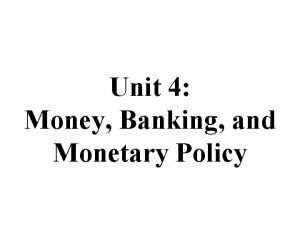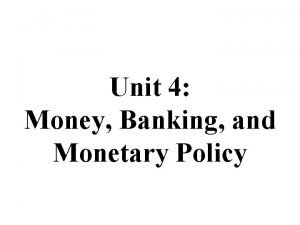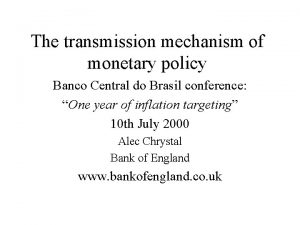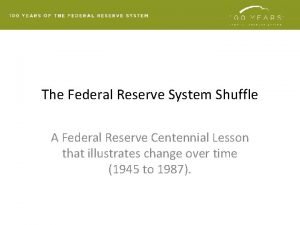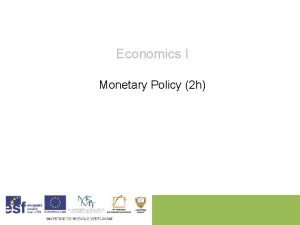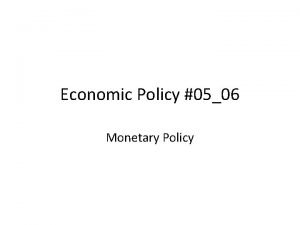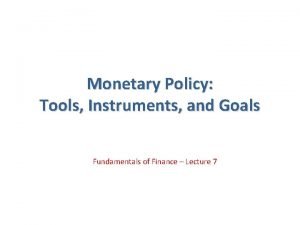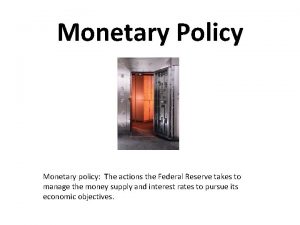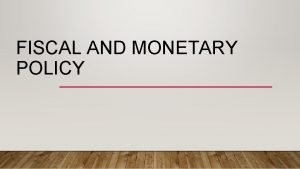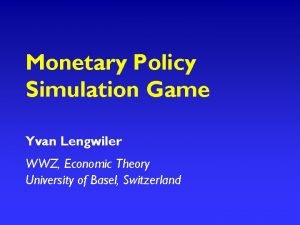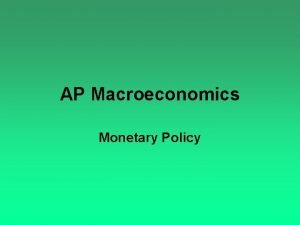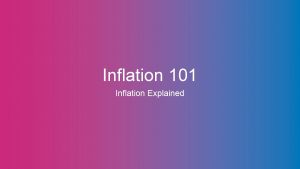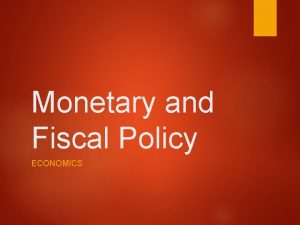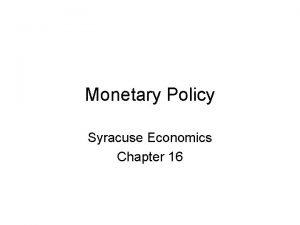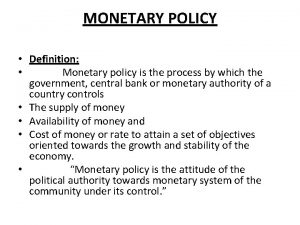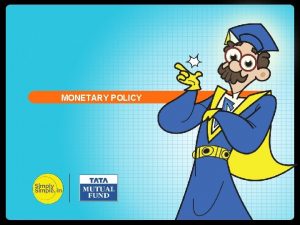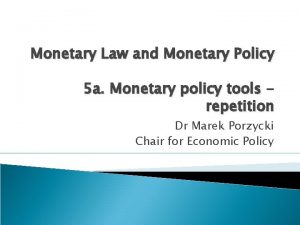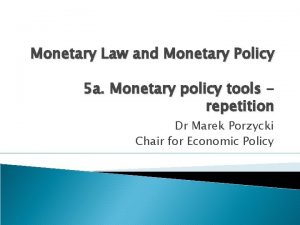Monetary policy Economics Understanding Inflation Definition of inflation

















- Slides: 17

Monetary policy Economics

Understanding Inflation • Definition of inflation: a rise in the general prices over a substantial period of time • Causes of inflation: – Too many dollars chasing too few goods-demandpull inflation – Increased cost of making and selling goods-cost push inflation

CPI • Used to measure rate of inflation • Calculated by looking at 400 items bought on a regular basis by urban families

Harmful effects of rapid inflation • Makes people worse off when their incomes don’t rise as rapidly as the overall price level • Cause lenders to lose money because they may be repaid with dollars that have less value than when they made their loans • Causes savers to lose money because a dollar they save today will have less value in the future when it is spent

Harmful effects of rapid inflation • Makes it harder for businesses to plan, which may reduce investment in future projects • Causes owners of financial assets to suffer when those assets don’t increase in value as much as price levels rise • Interest rates- sensitive industries such as mortgage lenders may suffer as inflation drives up long term interest rates and the Fed tightening raises short term interest rates

Harmful effects of rapid inflation • Monetary policy designed to slow inflation typically results in lost output and employment in the short run

The Tools of Monetary Policy

Understanding monetary policy • The primary objective of monetary policy is to influence the amount of money and credit in the economy in order to help promote sustainable economic growth, full employment and stable prices.

Understanding monetary policy • The Federal Open Market Committee (FOMC) meets approximately 8 times a year to formulate the nation’s monetary policy

Understanding monetary policy • Monetary policy is formulated in terms of a target for the federal funds rate – The interest rate that banks charge one another for short term loans – Changes to the federal funds rate typically affect other short-term commercial lending rates

The tools of monetary policy • Open market operations: –Involves the buying and selling of U. S. securities

The tools of monetary policy • Discount rate –The interest rate charged on shortterm loans to the depository institutions by the Fed

The tools of monetary policy • Reserve requirements –Changing the percentage of deposits that banks must keep on reserve in their vaults or on deposit at a Federal Reserve Bank

Tight Money Policy • The Fed sells Treasury securities taking money out of the economy (banks use money they have to buy these securities, thus taking money out of circulation) • Short term interest rates may go up because banks have less money to lend

Tight Money Policy • Consumers and businesses may borrow less money • Consumer and business spending may decrease • Employment and economic growth may decrease in the short term

Loose Monetary Policy • The Fed buys Treasury securities add money to the economy (The Fed buys these from banks which means they have more money to lend to consumers) • Short-term interest rates may go down because banks have more money to lend

Loose Monetary Policy • Consumers and businesses may borrow more money • Consumer spending may increase • Employment and economic growth may increase in the short term
 Unit 4 money banking and monetary policy
Unit 4 money banking and monetary policy Unit 4 money banking and monetary policy
Unit 4 money banking and monetary policy Transmission mechanism
Transmission mechanism Lesson quiz 16-1 monetary policy
Lesson quiz 16-1 monetary policy Objectives of monetary policy
Objectives of monetary policy What is the meaning of monetary policy
What is the meaning of monetary policy Monetary policy types
Monetary policy types Macroeconomics lesson 2 activity 45
Macroeconomics lesson 2 activity 45 What are the objectives of monetary policy
What are the objectives of monetary policy What are the objectives of monetary policy
What are the objectives of monetary policy Contractionary monetary policy
Contractionary monetary policy Three tools of monetary policy
Three tools of monetary policy Monetary policy summary
Monetary policy summary Fiscal vs monetary policy
Fiscal vs monetary policy Monetary policy simulation game
Monetary policy simulation game Types of monetary policy
Types of monetary policy Instruments of monetary policy
Instruments of monetary policy Cost-push inflation
Cost-push inflation
